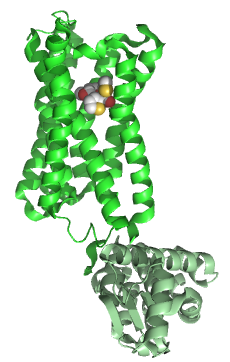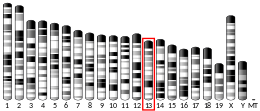The muscarinic acetylcholine receptor, also known as cholinergic/acetylcholine receptor M3, or the muscarinic 3, is a muscarinic acetylcholine receptor encoded by the human gene CHRM3.[5]
The M3 muscarinic receptors are located at many places in the body, e.g., smooth muscles, the bladder, the endocrine glands, the exocrine glands, lungs, pancreas and the brain. In the CNS, they induce emesis. Muscarinic M3 receptors are expressed in regions of the brain that regulate insulin homeostasis, such as the hypothalamus and dorsal vagal complex of the brainstem.[6] These receptors are highly expressed on pancreatic beta cells and are critical regulators of glucose homoestasis by modulating insulin secretion.[7] In general, they cause smooth muscle contraction and increased glandular secretions.[5]
Mechanism
editLike the M1 muscarinic receptor, M3 receptors are coupled to G proteins of class Gq, which upregulate phospholipase C and, therefore, inositol trisphosphate and intracellular calcium as a signalling pathway.[8] The calcium function in vertebrates also involves activation of protein kinase C and its effects.
Effects
editSmooth muscle
editBecause the M3 receptor is Gq-coupled and mediates an increase in intracellular calcium, it typically causes constriction of smooth muscle, such as that observed during bronchoconstriction. However, with respect to vasculature, activation of M3 on vascular endothelial cells causes increased synthesis of nitric oxide, which diffuses to adjacent vascular smooth muscle cells and causes their relaxation and vasodilation, thereby explaining the paradoxical effect of parasympathomimetics on vascular tone and bronchiolar tone. Indeed, direct stimulation of vascular smooth muscle M3 mediates vasoconstriction in pathologies wherein the vascular endothelium is disrupted.[9]
Diabetes
editThe muscarinic M3 receptor regulates insulin secretion from the pancreas[7] and are an important target for understanding the mechanisms of type 2 diabetes mellitus.
Some antipsychotic drugs that are prescribed to treat schizophrenia and bipolar disorder (such as olanzapine and clozapine) have a high risk of diabetes side-effects. These drugs potently bind to and block the muscarinic M3 receptor, which causes insulin dysregulation that may precede diabetes.[6]
Other
editThe M3 receptors are also located in many glands, both endocrine and exocrine glands, and help to stimulate secretion in salivary glands and other glands of the body.
Other effects are:
- increased secretions from stomach
- eye accommodation
Ligands
editAgonists
editNo highly selective M3 agonists are yet available as of 2018, but a number of non-selective muscarinic agonists are active at M3.
- acetylcholine
- bethanechol
- carbachol[10]
- L-689,660 (mixed M1/M3 agonist)
- oxotremorine[10]
- pilocarpine (in eye)
- muscarine
Antagonists
edit- aclidinium bromide
- 4-DAMP (1,1-Dimethyl-4-diphenylacetoxypiperidinium iodide, CAS# 1952-15-4)
- darifenacin
- diphenhydramine
- fluoxetine
- DAU-5884 (8-Methyl-8-azabicyclo-3-endo[1.2.3]oct-3-yl-1,4-dihydro-2-oxo-3(2H)-quinazolinecarboxylic acid ester, CAS# 131780-47-7)
- HL-031,120 ((3R,2'R)-enantiomer of EA-3167)
- ipratropium[10]
- J-104,129 ((aR)-a-Cyclopentyl-a-hydroxy-N-[1-(4-methyl-3-pentenyl)-4-piperidinyl]benzeneacetamide, CAS# 244277-89-2)
- oxybutynin[10]
- procyclidine
- tiotropium
- tolterodine[10]
- zamifenacin ((3R)-1-[2-(1-,3-Benzodioxol-5-yl)ethyl]-3-(diphenylmethoxy)piperidine, CAS# 127308-98-9)
- solifenacin
Interactions
editMuscarinic acetylcholine receptor M3 has been shown to pre-couple with Gq proteins. The polybasic c-tail of the receptor is necessary for the pre-coupling.[8] It has also been shown to interact with Arf6[13] and ARF1.[13]
See also
editReferences
edit- ^ a b c GRCh38: Ensembl release 89: ENSG00000133019 – Ensembl, May 2017
- ^ a b c GRCm38: Ensembl release 89: ENSMUSG00000046159 – Ensembl, May 2017
- ^ "Human PubMed Reference:". National Center for Biotechnology Information, U.S. National Library of Medicine.
- ^ "Mouse PubMed Reference:". National Center for Biotechnology Information, U.S. National Library of Medicine.
- ^ a b "Entrez Gene: CHRM3 cholinergic receptor, muscarinic 3".
- ^ a b Weston-Green K, Huang XF, Lian J, Deng C (May 2012). "Effects of olanzapine on muscarinic M3 receptor binding density in the brain relates to weight gain, plasma insulin and metabolic hormone levels". European Neuropsychopharmacology. 22 (5): 364–373. doi:10.1016/j.euroneuro.2011.09.003. PMID 21982116. S2CID 31739607.
- ^ a b Gautam D, Han SJ, Hamdan FF, Jeon J, Li B, Li JH, et al. (June 2006). "A critical role for beta cell M3 muscarinic acetylcholine receptors in regulating insulin release and blood glucose homeostasis in vivo". Cell Metabolism. 3 (6): 449–461. doi:10.1016/j.cmet.2006.04.009. hdl:10533/177761. PMID 16753580.
- ^ a b c Qin K, Dong C, Wu G, Lambert NA (August 2011). "Inactive-state preassembly of G(q)-coupled receptors and G(q) heterotrimers". Nature Chemical Biology. 7 (10): 740–747. doi:10.1038/nchembio.642. PMC 3177959. PMID 21873996.
- ^ Keith Parker, Laurence Brunton, Goodman, Louis Sanford, Lazo, John S., Gilman, Alfred (2006). Goodman & Gilman's the pharmacological basis of therapeutics (11th ed.). New York: McGraw-Hill. pp. 185. ISBN 0-07-142280-3.
- ^ a b c d e f Rang HP, Dale MM, Ritter JM, Moore PK (2003). "Ch. 10". Pharmacology (5th ed.). Elsevier Churchill Livingstone. pp. 139. ISBN 0-443-07145-4.
- ^ Shiga Y, Minami K, Shiraishi M, Uezono Y, Murasaki O, Kaibara M, Shigematsu A (November 2002). "The inhibitory effects of tramadol on muscarinic receptor-induced responses in Xenopus oocytes expressing cloned M(3) receptors". Anesthesia and Analgesia. 95 (5): 1269–73, table of contents. doi:10.1097/00000539-200211000-00031. PMID 12401609. S2CID 39621215.
- ^ Edwards Pharmaceuticals, Inc., Belcher Pharmaceuticals, Inc. (May 2010). "DailyMed". U.S. National Library of Medicine. Retrieved January 13, 2013.
- ^ a b Mitchell R, Robertson DN, Holland PJ, Collins D, Lutz EM, Johnson MS (September 2003). "ADP-ribosylation factor-dependent phospholipase D activation by the M3 muscarinic receptor". The Journal of Biological Chemistry. 278 (36): 33818–33830. doi:10.1074/jbc.M305825200. PMID 12799371.
Further reading
edit- Goyal RK (October 1989). "Muscarinic receptor subtypes. Physiology and clinical implications". The New England Journal of Medicine. 321 (15): 1022–1029. doi:10.1056/NEJM198910123211506. PMID 2674717.
- Eglen RM, Reddy H, Watson N, Challiss RA (April 1994). "Muscarinic acetylcholine receptor subtypes in smooth muscle". Trends in Pharmacological Sciences. 15 (4): 114–119. doi:10.1016/0165-6147(94)90047-7. PMID 8016895.
- Brann MR, Ellis J, Jørgensen H, Hill-Eubanks D, Jones SV (1993). "Chapter 12: Muscarinic acetylcholine receptor subtypes: Localization and structure/Function". Cholinergic Function and Dysfunction. Progress in Brain Research. Vol. 98. pp. 121–127. doi:10.1016/S0079-6123(08)62388-2. ISBN 9780444897176. PMID 8248499.
- Gutkind JS, Novotny EA, Brann MR, Robbins KC (June 1991). "Muscarinic acetylcholine receptor subtypes as agonist-dependent oncogenes". Proceedings of the National Academy of Sciences of the United States of America. 88 (11): 4703–4707. Bibcode:1991PNAS...88.4703G. doi:10.1073/pnas.88.11.4703. PMC 51734. PMID 1905013.
- Ashkenazi A, Ramachandran J, Capon DJ (July 1989). "Acetylcholine analogue stimulates DNA synthesis in brain-derived cells via specific muscarinic receptor subtypes". Nature. 340 (6229): 146–150. Bibcode:1989Natur.340..146A. doi:10.1038/340146a0. PMID 2739737. S2CID 4312544.
- Bonner TI, Buckley NJ, Young AC, Brann MR (July 1987). "Identification of a family of muscarinic acetylcholine receptor genes". Science. 237 (4814): 527–532. Bibcode:1987Sci...237..527B. doi:10.1126/science.3037705. PMID 3037705.
- Bonner TI, Young AC, Brann MR, Buckley NJ (July 1988). "Cloning and expression of the human and rat m5 muscarinic acetylcholine receptor genes". Neuron. 1 (5): 403–410. doi:10.1016/0896-6273(88)90190-0. PMID 3272174. S2CID 833230.
- Peralta EG, Ashkenazi A, Winslow JW, Smith DH, Ramachandran J, Capon DJ (December 1987). "Distinct primary structures, ligand-binding properties and tissue-specific expression of four human muscarinic acetylcholine receptors". The EMBO Journal. 6 (13): 3923–3929. doi:10.1002/j.1460-2075.1987.tb02733.x. PMC 553870. PMID 3443095.
- Blin N, Yun J, Wess J (July 1995). "Mapping of single amino acid residues required for selective activation of Gq/11 by the m3 muscarinic acetylcholine receptor". The Journal of Biological Chemistry. 270 (30): 17741–17748. doi:10.1074/jbc.270.30.17741. PMID 7629074.
- Crespo P, Xu N, Daniotti JL, Troppmair J, Rapp UR, Gutkind JS (August 1994). "Signaling through transforming G protein-coupled receptors in NIH 3T3 cells involves c-Raf activation. Evidence for a protein kinase C-independent pathway". The Journal of Biological Chemistry. 269 (33): 21103–21109. doi:10.1016/S0021-9258(17)31935-X. PMID 8063729.
- Haga K, Kameyama K, Haga T, Kikkawa U, Shiozaki K, Uchiyama H (February 1996). "Phosphorylation of human m1 muscarinic acetylcholine receptors by G protein-coupled receptor kinase 2 and protein kinase C". The Journal of Biological Chemistry. 271 (5): 2776–2782. doi:10.1074/jbc.271.5.2776. PMID 8576254.
- Szekeres PG, Koenig JA, Edwardson JM (April 1998). "The relationship between agonist intrinsic activity and the rate of endocytosis of muscarinic receptors in a human neuroblastoma cell line". Molecular Pharmacology. 53 (4): 759–765. doi:10.1124/mol.53.4.759. PMID 9547368.
- von der Kammer H, Mayhaus M, Albrecht C, Enderich J, Wegner M, Nitsch RM (June 1998). "Muscarinic acetylcholine receptors activate expression of the EGR gene family of transcription factors". The Journal of Biological Chemistry. 273 (23): 14538–14544. doi:10.1074/jbc.273.23.14538. PMID 9603968.
- Ndoye A, Buchli R, Greenberg B, Nguyen VT, Zia S, Rodriguez JG, et al. (September 1998). "Identification and mapping of keratinocyte muscarinic acetylcholine receptor subtypes in human epidermis". The Journal of Investigative Dermatology. 111 (3): 410–416. doi:10.1046/j.1523-1747.1998.00299.x. PMID 9740233.
- Goodchild RE, Court JA, Hobson I, Piggott MA, Perry RH, Ince P, et al. (February 1999). "Distribution of histamine H3-receptor binding in the normal human basal ganglia: comparison with Huntington's and Parkinson's disease cases". The European Journal of Neuroscience. 11 (2): 449–456. doi:10.1046/j.1460-9568.1999.00453.x. PMID 10051746. S2CID 30498817.
- Sato KZ, Fujii T, Watanabe Y, Yamada S, Ando T, Kazuko F, Kawashima K (April 1999). "Diversity of mRNA expression for muscarinic acetylcholine receptor subtypes and neuronal nicotinic acetylcholine receptor subunits in human mononuclear leukocytes and leukemic cell lines". Neuroscience Letters. 266 (1): 17–20. doi:10.1016/S0304-3940(99)00259-1. PMID 10336173. S2CID 43548155.
- Budd DC, McDonald JE, Tobin AB (June 2000). "Phosphorylation and regulation of a Gq/11-coupled receptor by casein kinase 1alpha". The Journal of Biological Chemistry. 275 (26): 19667–19675. doi:10.1074/jbc.M000492200. PMID 10777483.
External links
edit- "Acetylcholine receptors (muscarinic): M3". IUPHAR Database of Receptors and Ion Channels. International Union of Basic and Clinical Pharmacology. Archived from the original on 2013-11-03. Retrieved 2008-11-25.
- Overview of all the structural information available in the PDB for UniProt: P20309 (Human Muscarinic acetylcholine receptor M3) at the PDBe-KB.
- Overview of all the structural information available in the PDB for UniProt: P08483 (Rat Muscarinic acetylcholine receptor M3) at the PDBe-KB.
This article incorporates text from the United States National Library of Medicine, which is in the public domain.




